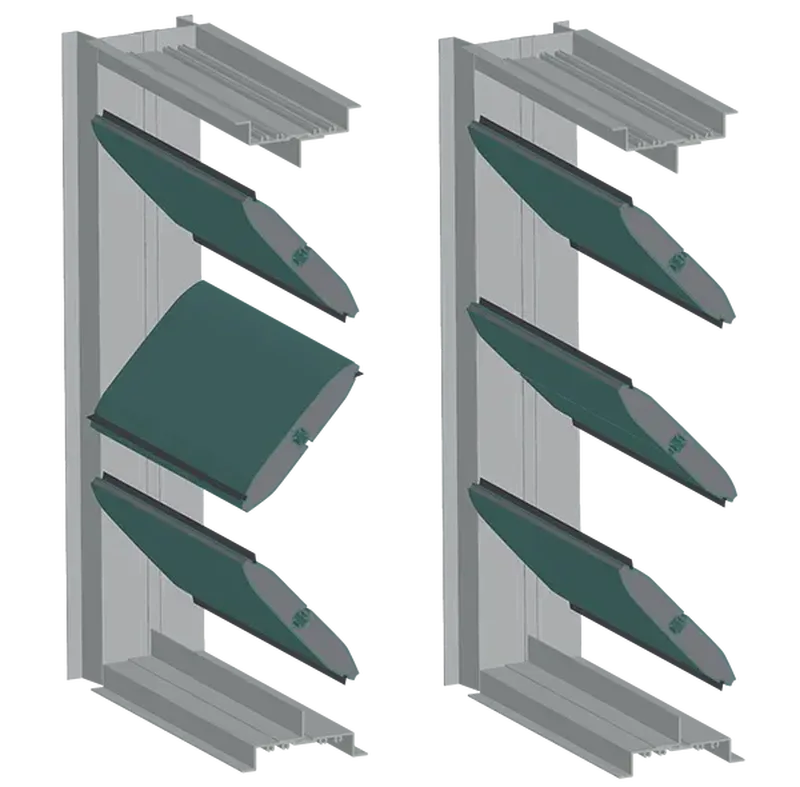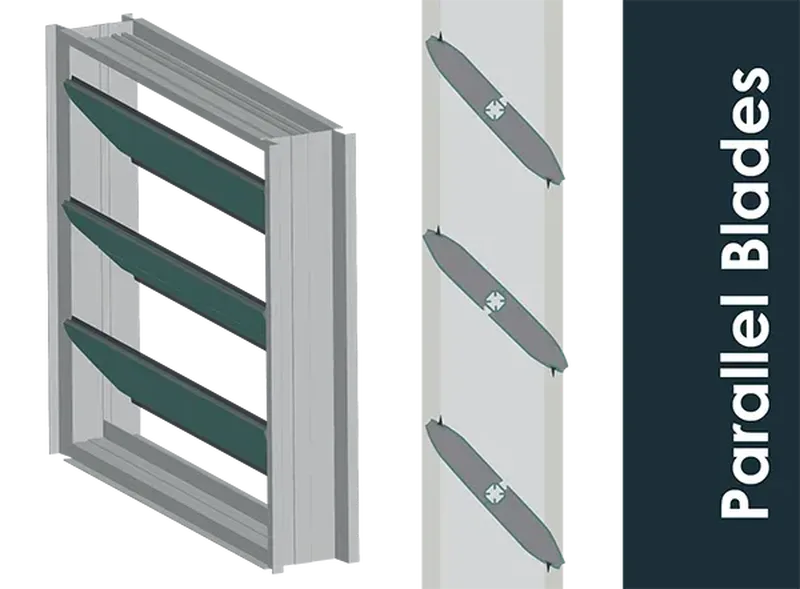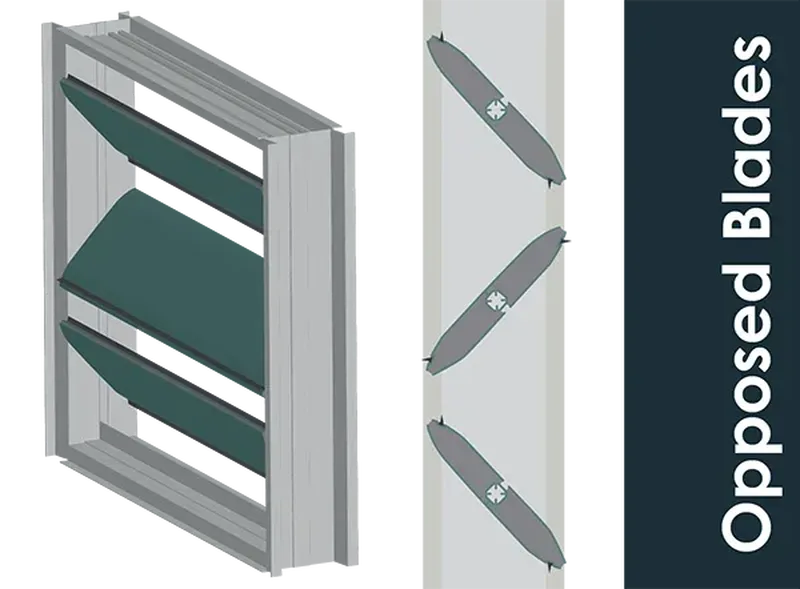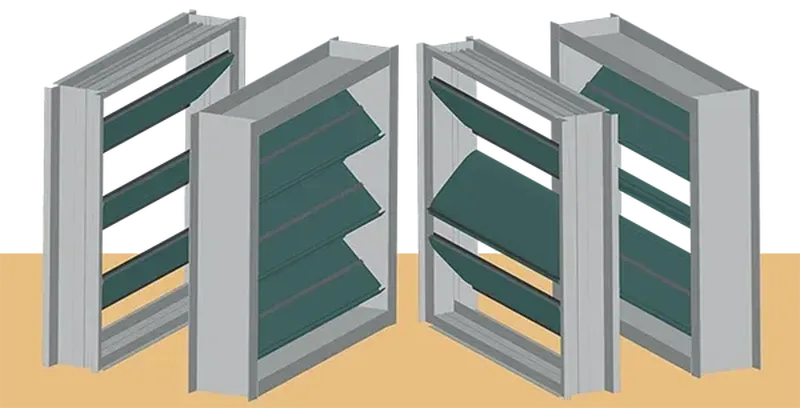Blade Action for HVAC Dampers
HVAC dampers will fulfil several roles in your ductwork, from basic flow control to pressure balancing. Their exact role will differ depending on damper type and construction, but their goal will be the same: to keep air moving through the system. The differences between damper types are often obvious.
A backdraft damper will have blades with off-center axles, resembling a flap. Tunnel dampers will be made from thick, heavy-duty metals for withstanding intense heat and air pressures. It is easy to spot the difference between a tunnel damper and a standard control damper. However, a minor change to the way the damper’s blades rotate can change the role the damper will play in your system.

The Difference Between Parallel and Opposed
A control damper with parallel blades will perform a different task than a damper with opposed blades. Blade rotation is commonly referred to as either “parallel” or “opposed”. In this article, we will refer to this as blade action. Manufacturers will often split the same damper into two separate models, one for parallel blade action and one for opposed. This is because blade action will change what the damper will do. We do this with our own dampers at AWV.
The VC-26 and VC-27 are the same damper with the same blades and frame, but the VC-27 will have opposed blades while the VC-26 will have parallel blade action. The difference comes down to the damper’s linkage. The linkage of a parallel damper will be simple. For parallel blade action, a single linkage bar will connect all blades to the damper’s driving blade, or the blade rotated by the actuator. When the driving blade rotates, all blades will rotate at the same time and to the same angle.

For opposed blade action, the damper will have two linkage bars. One linkage bar will tie the driving blade to several other blades, so that they rotate in the same direction. The second linkage bar will tie the remaining blades to the driving blade, but this linkage bar will be configured to rotate the connected blades in the opposite direction. The result is an opposed blade action where each blade rotates in the opposite direction of its neighbors.
Which Action is Best?
Parallel blades will come together edge to edge when the damper closes, so that the edge of the top blade overlaps with the edge of the bottom blade. For single thickness blades, the edges can be designed to interlock so that the seals of one blade meet the seals of another. This creates a tighter closure that minimizes air leakage through the closed damper. Parallel blades will appear to overlap when the damper closes, creating a flat profile along the height of the damper. Parallel blades quickly close off the duct when air is no longer moving through the damper.
Parallel blade action is best for directing and regulating airflow, so that air has a defined path through the ductwork. Opposed blades also meet edge to edge when closed, but the resulting profile isn’t flat. The blades edges will meet before they rotate to a flat profile. The closed blades will make a zig-zag profile, where the back edge of the top blade meets with the back edge of the bottom blade. This can provide extra torque when the damper is closed.
The main purpose of opposed blade action is air flow modulation or changing the amount of air moving through the damper. Opposed blades can open to a specific spacing, which restricts or frees the air stream as it moves through the damper. This is excellent for applications that require careful air balancing. For air modulation, the damper will need a modulating actuator.

What if a damper only has one blade? Round dampers will typically have a single damper blade at the center of the damper. Rectangular and square dampers can also have only one blade, depending on their size and their intended application. Singe-blade dampers won’t have linkage because the actuator only needs to rotate one blade. Backdraft and pressure relief dampers don’t have linkage either because they rely on airflow to open and close.
Single-blade dampers are typically used for air balancing, like opposed blade dampers. The blade will be adjusted to a particular angle and then locked in place. This will adjust the flow of air moving through the damper, and it will also reduce the air pressure. Dampers that keep a specific blade angle are referred to as “balancing dampers” because their main goal is to balance air pressure through the duct. Single-blade dampers can also be used for regulating airflow, like a parallel blade damper. The single blade can rotate quickly between open and close.
Which blade action should you choose? It depends on what you need the damper to do. Different applications will call for dampers with a particular blade action. The best way to know is to understand the application.

AWV and HVAC Dampers
AWV offers control dampers for a wide range of applications. Our multi-blade dampers can be configured with parallel or opposed blade action. We mentioned the VC-26 and VC-27, volume control dampers with airflow blades. This damper provides tight closure for either blade action, minimizing air leakage while the damper is closed. The VC-20 and VC-21 are similar dampers with single-thickness blades.
Looking for the right damper to fulfill a requirement? We can help you find it. AWV has over one hundred years in the HVAC business. We manufacture every damper and louver to your specifications. We can build the perfect dampers for your HVAC system. Contact AWV today and start your project with us!






